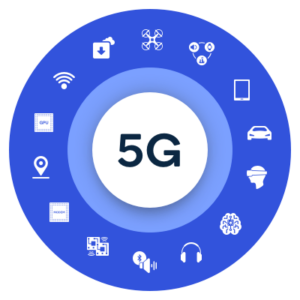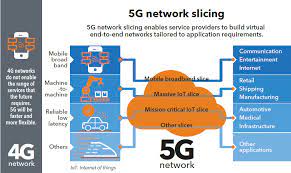An Introduction to 5G

With 2.5 quintillion bytes of data produced by humans daily, it is easy to understand the importance of wireless communication.
The pace at which technology is expanding – from artificial intelligence to self-driving cars and telemedicine in healthcare there is no doubt in the statement that internet connectivity is the future.
With 5G comes to the Fourth Industrial Revolution– Let us see how.
Why 5G networks are required, or why are they being developed?

We have been using the 4g network all-around to make calls, send messages, and surf the web. Now, with all the hype, it is to be replaced by 5G. This wireless communications technology, aka 5G, is becoming increasingly important over time because of its ability to transform the internet.
Some reasons for the development of 5G networks:
- Better opportunities: As per predictions, by 2035, 5G will enable $12.3 trillion of global economic output and support 22 million jobs worldwide.
- Improved accessibility: 5G has high accessibility when compared with 4G. It can handle thousands of devices simultaneously, from gadgets to equipment sensors and robots to medical devices.
- Network improvements: Lower latency, higher capacity, and increased bandwidth are some of the main factors of the 5G network.
- Internet of Things: 5G is the conduit for the Internet of Things, which are smart-devices that are interconnected, making real-time data exchanges. Machines will communicate with one another to coordinate and perform remarkably complex tasks.
By facilitating increased access to information on the go, 5G networks have facilitated improvements in business, education, and technology all around the world. As connectivity improve, so does the connections among people.
How 5G technically different from 4G or 3G

No, 5G is not 4G + 1G.
Well, there is a reason there is so much buzz about this upcoming wireless technology.
Now, each generation not only comes with improved speed, but with technical enhancements, improvements, specifications, and protocols. The same is with this 5G network.
- Frequency Band: The fundamental aspect of 5G that needs to be paid attention to is the frequency band that it supports. Where 4G LTE offers only up to 2.5GHz, 5G covers a wide spectrum from 1GHz to an impressive 95GHz
- Latency: Latency is the average time taken to respond to the data/information from one device to another. In 4G networks, the latency is about 50 milliseconds, while 5G networks are expected to shrink that to a whooping 1 ms.
- Internet Capacity: 5g is a software-defined network–it means it operates on the cloud. It results in offering 100x better capacity than 4g, which will dramatically improve internet speeds. For example, to download a two-hour film on 3g would take about 26 hours on the 4G you had been waiting 6 minutes, and on the 5G, you will be ready to watch a film in just over three and half seconds
- Speed: It is one of the main aspects in differentiating 5G with previous generations of networks. Where 4G used to offer the maximum speed of 100mpbs, 5G has the potential to offer an impressive speed of 100 times faster, which marks up to 20Gbps.
Technical Challenges in Developing 5G Network

Jump from 3G to 4G was much faster, and as soon as the network developed, it was implemented. But it took much longer for 5G. The reason behind this is the high frequency that it offers. When we shifted from 3g to 4g, yes, the speed was higher, but there was a negligible change in the frequency.
This high frequency means the low wavelength. (Remember, frequency is inversely proportional to the wavelength). The frequency with which 5G operates cannot even surpass the wall of a house. And for a country like India, where the population density is so high, there are so many radio locations that need to be built within small distances to offer the 5G connectivity. It is the principal reason there is so much delay in the development of the 5G network.
Another reason why the development of 5G is facing multiple hurdles is, of course, the cost. According to some experts, 5g could cause network operators to tear up their current business models for it to make business sense.
Technical Challenges in Implementing 5G Network

Implementing wireless technology comes with its challenges.
5G cannot surpass many barriers as much as 4G can do. So there is a need to connect many 5g radio access points, which could be radio masts or just small aerials in the size of a building back to the internet. It could be achievable by setting up fiber to microwaves or even satellite, but it is all made more complicated by the type of spectrum available for 5g.
Frequency is inversely proportional to wavelength. Low-frequency radio waves are better than long-distance connectivity. Much of the spectrum to 5G will be assigned in the higher frequencies, and for 5G to work in these high frequencies for radio waves to travel much shorter distances, we will have to build many more radio locations such as lampposts. It results in a rise in expenditure.
There is no proof that this high-frequency radiation that 5G offers is safe for the human body.
Benefits of 5G

There is a reason the world is getting gaga over these two letters – 5G. There are many benefits that this network offers.
- The first one being higher data rates, lower latency, and increased capacity, which results in a virtually connected world.
- The next one is the development of the Internet of Things (IoT) transformation.
- 5G network connects the world so, technology such as household robots, self-driving cars, and growth in the automated healthcare system will be much faster.
Use cases 1 – Autonomous Vehicles

Well, this is the most trending one. The wireless flexibility, reduced costs, and the dramatically reduced latency that 5G offers are not possible with the current 4G network. 5G network will bring a boom in the automation of vehicles.
- Reduced latency will cause a faster response time (100 times faster than the current network).
- Faster response time results in a high and fast connection between vehicles to nearby objects so that vehicles can run smoothly and exchange communications via nearby objects instantaneously.
Use cases 2 – Healthcare

Technological advancements in the healthcare system are also seen, with development in the 5G network.
- Remote diagnosis/robotic surgery will help the patients living in remote locations as they do not need to travel physically to get the consultations done.
- Actual time EHR benefits patients in getting the faster diagnosis via tests and reports instead of waiting for doctors to examine the reports manually.
- Preventive healthcare measures such as wearables and ingestible help in decreasing the costs in the long term.
- Faster networks also help in maintaining a real-time and efficient record of patient’s data in database management.
Our Final Thoughts
With so much research and development, it is sure that 5G will be an asset for economic growth. There will be a lot of transformations that are not viable in the present network and make our life easier and grow higher.
The only issue with this network is the time it is required in the implementation. Well, it may take a little longer to build the 5G network overall. SO it is better to invest in the future with our current network and improve it as 5G executes.




